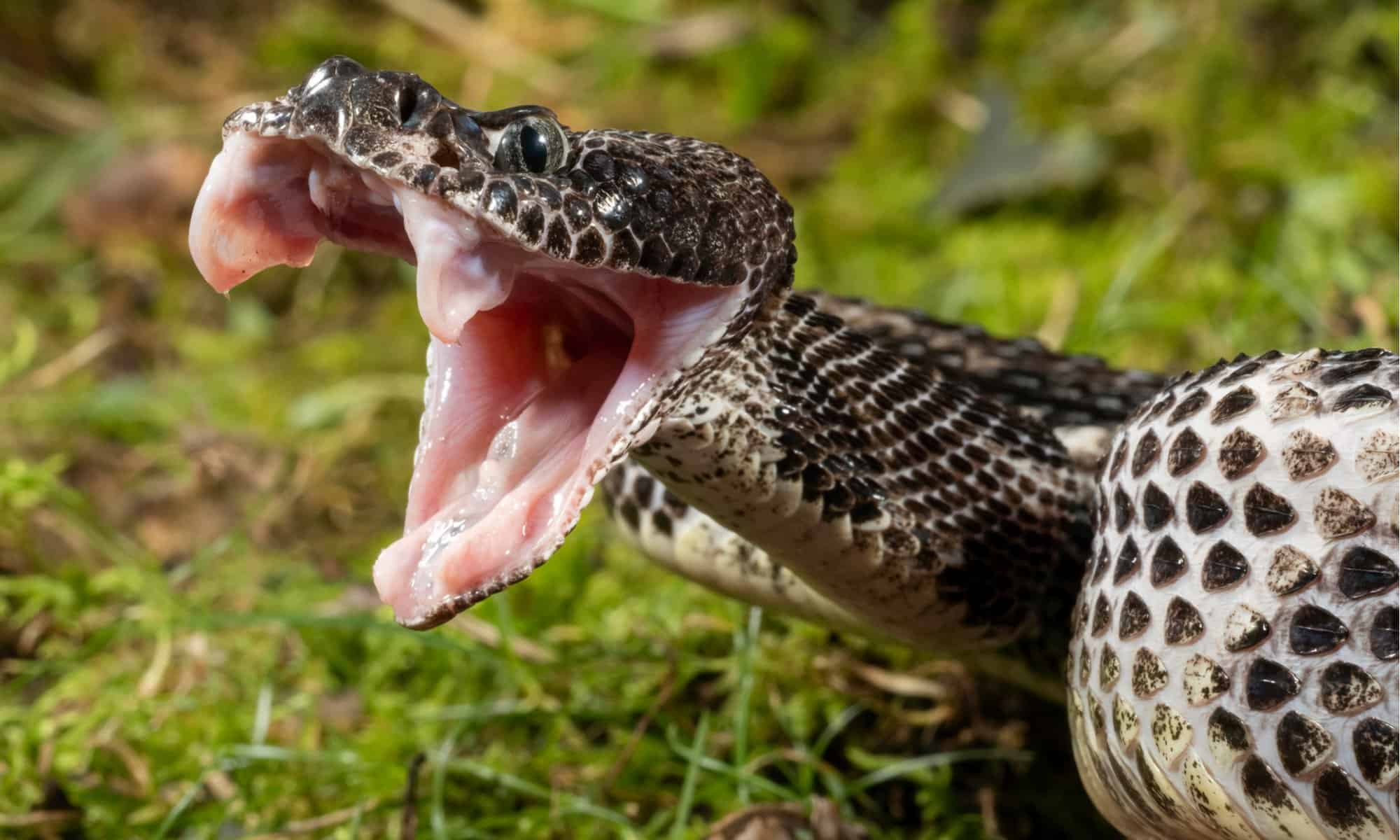Located between the Great Lakes and the Mississippi River, the midwestern state of Wisconsin is famous for its dairy farming, cheeseheads, beer, and the Green Bay Packers. In the midst of the hustle and bustle of life in Wisconsin, there is also a wide range of wildlife! Wisconsin is home to at least 21 species of snakes. Unfortunately, at least 14 types of snakes in Wisconsin are either threatened, endangered, or a Special Concern Species, including Wisconsin’s rattlesnakes.
While you might shudder to think of running into a rattlesnake in Wisconsin, it is important to remember that all the snakes in the state are vitally important to keeping the ecosystem balanced. In addition, rattlesnakes are quite rare in Wisconsin, so the chances of seeing one are low. This article will help you learn how to identify Wisconsin’s rattlesnakes so that you won’t fear enjoying your time outdoors. So, let’s take a look at the two types of rattlesnakes in Wisconsin!
Timber Rattlesnake
| Timber Rattlesnake | |
|---|---|
| Range | Western edge of Wisconsin |
| Length | 36-56 inches |
The first rattlesnake species found in Wisconsin is the timber rattlesnake. These large snakes only live along the western edge of Wisconsin. They prefer to live in deciduous forests and areas on the edges of woodlands during the summertime. Gravid female snakes (ones that are pregnant) and juvenile snakes, however, prefer to stay in open areas with bluff prairies (generally near their dens) during the summer because they like it to be a little warmer. But they also need to be able to avoid getting too hot by having places to go to get shade, like brush, trees, or rock shelves.
Timber rattlesnakes come out of brumation or hibernation (when they sleep for a long time during the winter) as early as April 1. However, they can also come out of hibernation well into June. They remain active throughout the summer, until as late as mid-October. Timber rattlesnakes breed in August, and female snakes give birth to their young in mid-August or mid-September the following year. Female timber rattlesnakes in Wisconsin usually only have babies once every three to four years.
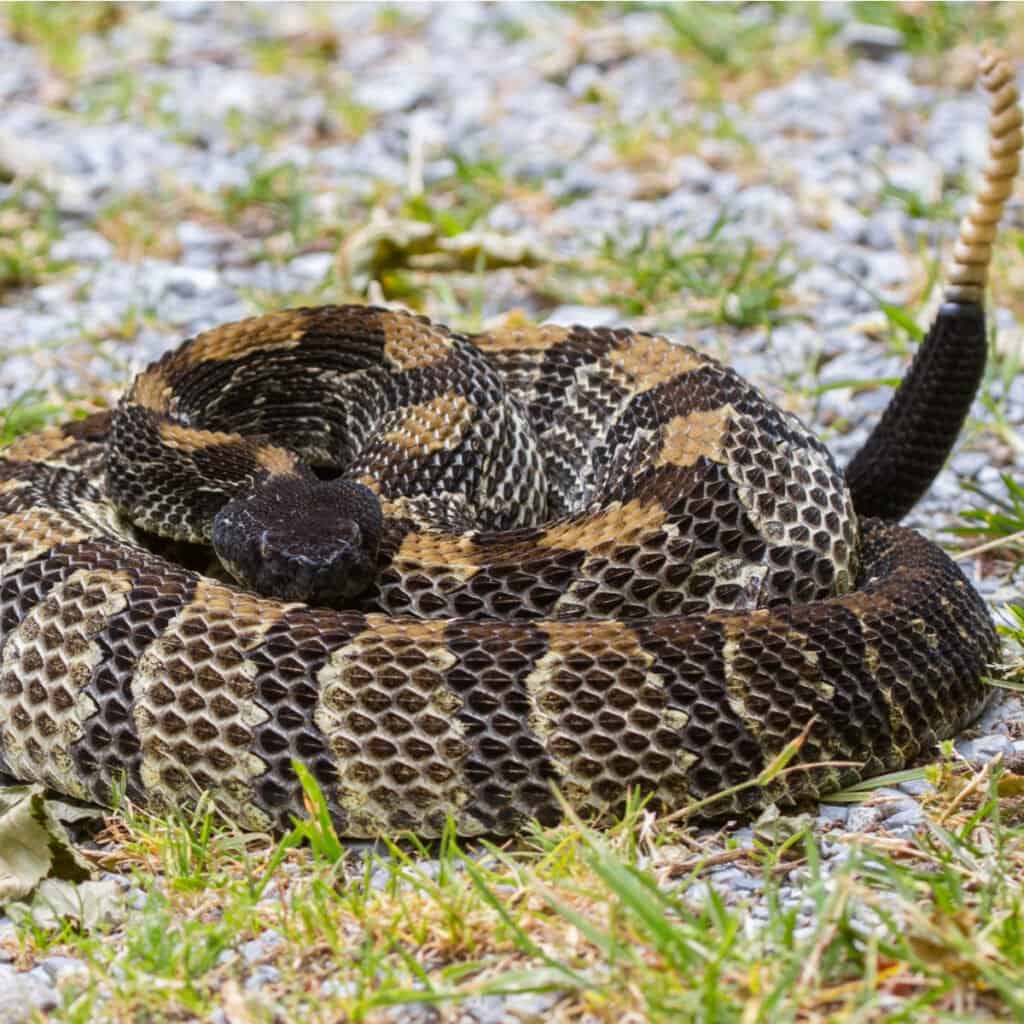
Be careful around timber rattlesnakes, with well-hidden camouflage.
©Frode Jacobsen/Shutterstock.com
Timber Rattlesnake Identification
Timber rattlesnakes are not very common in Wisconsin and are officially Protected Wild Animals in the state. They are also listed as a Special Concern Species. Timber rattlesnakes are large snakes with heavy bodies and keeled scales. They have big, triangular-shaped heads that are often a light gold color (although occasionally some snakes have blackheads). Timber rattlesnakes in Wisconsin typically grow between 36-56 inches long, with yellow, rust-orange, brown, or gray bodies. Dark brown or black zig-zag bands run along their backs, and the ends of their tails are black with a tan-colored rattle.
Although timber rattlesnakes are quite venomous and can be dangerous, they are extremely calm and rarely strike. Instead, they will first attempt to hide using their well-camouflaged bodies. If that doesn’t work, timber rattlesnakes will rattle a loud warning to try to scare off any threats. Most timber rattlesnake bites happen only because the snake was either purposefully harassed or because an unsuspecting hiker accidentally stepped on it! That is why it is so important to look carefully when you are enjoying the wild outdoors in Wisconsin.
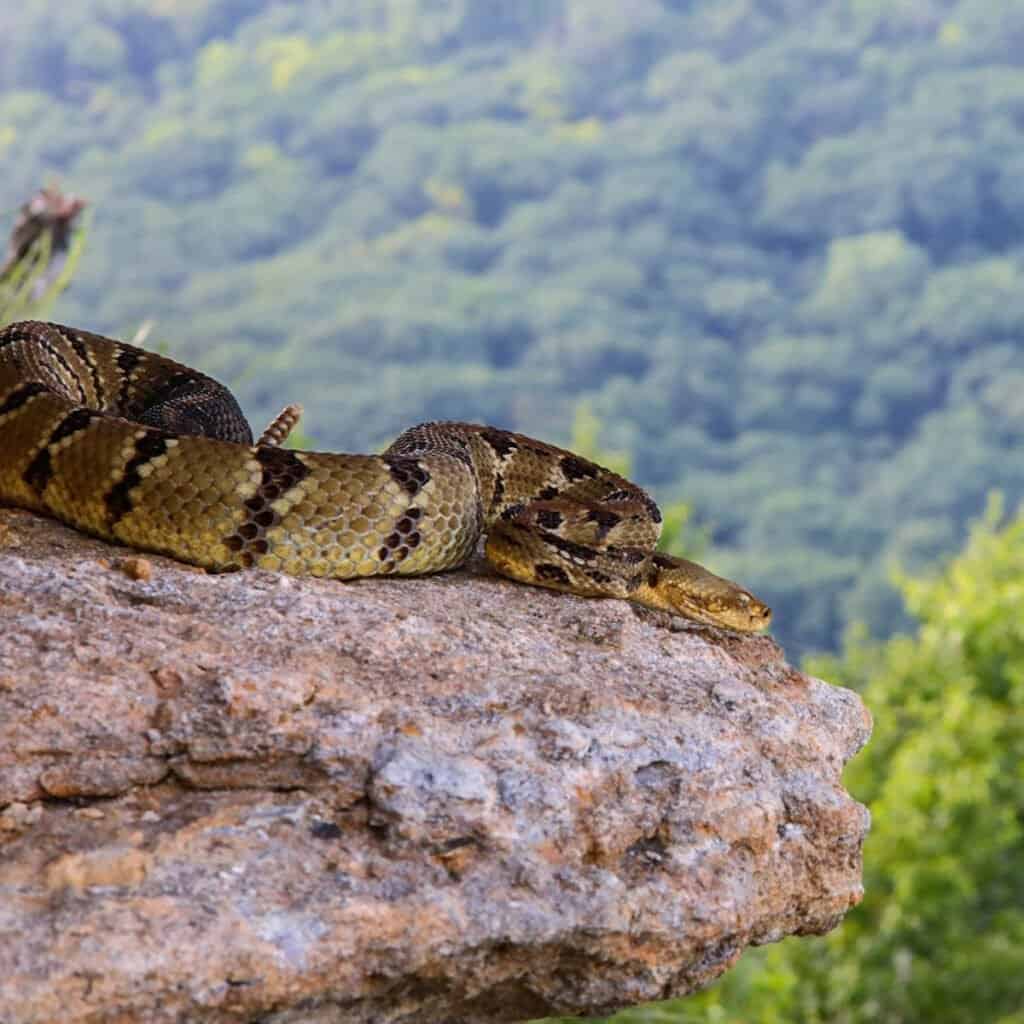
Timber rattlesnakes in Wisconsin typically grow between 36-56 inches long.
©bradenjalexander/Shutterstock.com
Eastern Massasauga Rattlesnake
| Eastern Massasauga Rattlesnake | |
|---|---|
| Range | Isolated pockets in southwestern Wisconsin |
| Length | 20-32 inches |
Wisconsin’s other rattlesnake species, the eastern massasauga rattlesnake, is even rare than the timber rattlesnake. Eastern massasaugas live in the southwestern areas of the state and are both Federally Threatened Species as well as State Endangered Species. They are sometimes called “swamp rattlers” because they prefer moist and wet areas along streams and rivers. They often live in floodplain habitats near rivers, open canopy wetlands, fresh wet meadows, sedge meadows, shrubby areas, or nearby upland prairies.
During the spring, eastern massasaugas begin to emerge from their winter brumation or hibernation, usually sometime in early April. They are active throughout the summer until the middle of November when they seek out underground mammal or crayfish burrows, sawdust piles, old stumps, and rotted-out root channels to sleep in for the winter. Eastern massasauga rattlesnakes breed in August, and female snakes give birth around the same time the following year.

Although they are venomous, eastern massasaugas are extremely secretive and shy.
©Ryan M. Bolton/Shutterstock.com
Eastern Massasauga Rattlesnake Identification
The smaller of Wisconsin’s two rattlesnake species, eastern massasauga rattlesnakes grow between 20-32 inches long. They have heavy bodies, keeled scales, and broad heads. Their bodies are usually light brown, tan, or gray, with brown blotches or “saddles” running along their backs and sides. There are five to seven dark rings at the end of the snake’s tail, just before its grayish-yellow rattle. There are three dark stripes and one white stripe on either side of the snake’s face.
Although they are venomous, eastern massasaugas are extremely secretive and shy and do their best to avoid people whenever possible. Furthermore, these snakes are extremely rare in Wisconsin, so you don’t need to worry about them. As long as you keep an eye out when you venture into the outdoors and give wildlife appropriate respect, you have no need to fear rattlesnakes in Wisconsin.
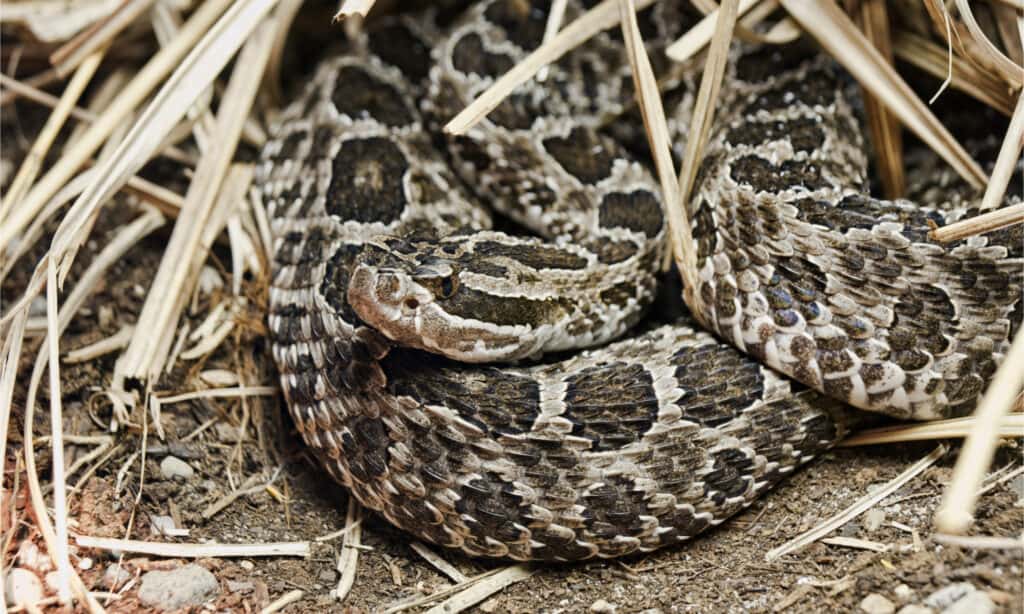
Sometimes called “swamp rattlers” because they prefer moist and wet areas along streams and rivers.
©DnDavis/Shutterstock.com
Wisconsin’s Rattlesnake Mimics
Although rattlesnakes in Wisconsin are very rare, there are many other snake species in the state that are often misidentified as rattlesnakes. This is due to their similar colors and patterns, and because of their defense mechanisms.
Many of Wisconsin’s snakes vibrate their tails when they feel threatened. If they vibrate their tails against gravel, vegetation, or dry leaves, they can make a rattling sound, much like a rattlesnake.
Some of these snakes also act surprisingly aggressively when they try to scare off predators, whereas the two rattlesnakes in Wisconsin are typically nonaggressive and shy. Here are a few examples of rattlesnake mimics in Wisconsin.
Eastern Fox Snake
| Eastern Fox Snake | |
|---|---|
| Range | All of Wisconsin |
| Length | 36-56 inches |
Found all over the state of Wisconsin, the eastern fox snake may look like a venomous snake, but it is completely harmless to humans! These snakes have tan bodies with reddish-brown blotches or patches and often mimic rattlesnakes when they feel threatened.
Many people mistake eastern fox snakes for rattlesnakes, or even for copperhead snakes (although they are no copperhead snakes in Wisconsin). Eastern fox snakes are common in prairies, old fields, meadows, and forests, and grow between 36-56 inches long.

Fox snakes are agile climbers but tend to stay closer to the ground.
©Ryan M. Bolton/Shutterstock.com
Bullsnake or Gopher Snake
| Bullsnake | |
|---|---|
| Range | Western Wisconsin |
| Length | 50-80 inches |
Another rattlesnake mimic in Wisconsin is the bullsnake or gopher snake, a large snake that grows between 50-80 inches long. These are some of the biggest and heaviest snakes living in Wisconsin and have rather thick bodies like timber rattlesnakes. However, bullsnakes have round pupils (as opposed to the vertical pupils of rattlesnakes) and are completely harmless to humans.
Although they can have colors and patterns similar to a rattlesnake, bullsnakes often have colors that change along their back. Some snakes almost look like three separate snakes that somehow got fused together! Bullsnakes live in western Wisconsin in oak savannas, oak and pine barrens, and sand prairies.
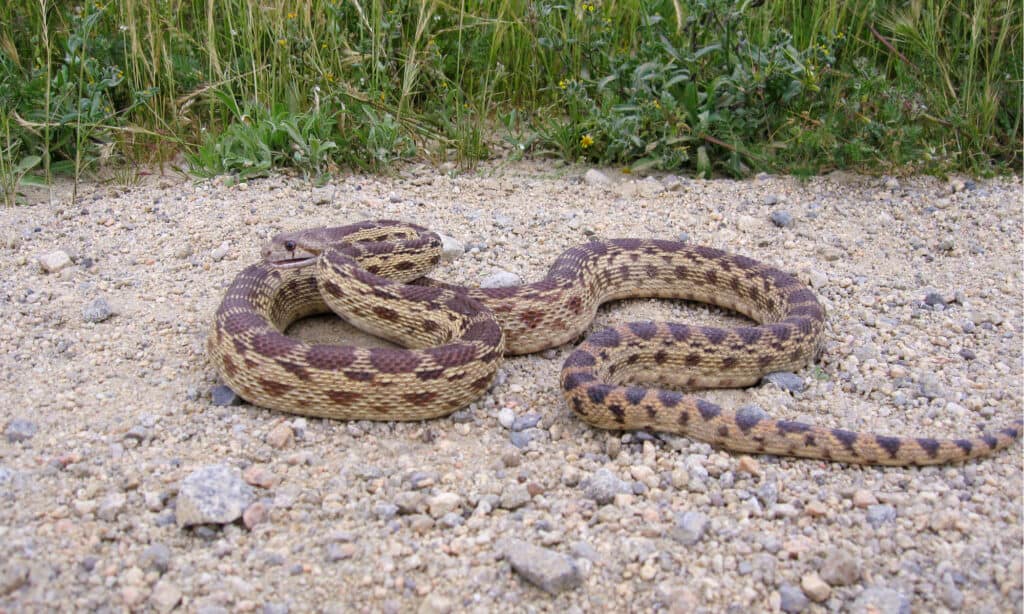
These are some of the biggest and heaviest snakes living in Wisconsin. They have rather thick bodies.
©rawaccess/Shutterstock.com
Milk Snake
| Milk Snake | |
|---|---|
| Range | Southern 2/3 of Wisconsin |
| Length | 24-36 inches |
Another harmless snake in Wisconsin is the eastern milk snake, a medium-sized snake that grows 24-36 inches long with smooth scales. Milk snakes live in the southern 2/3 of Wisconsin, typically in pastures, prairies, forests, savannas, vacant lots, and around farm buildings or older homes.
They have light brown or gray bodies with three rows of brown or red-brown blotches with black borders along their backs. Most milk snakes also have a “V”- or “Y”- shaped mark on top of their heads.
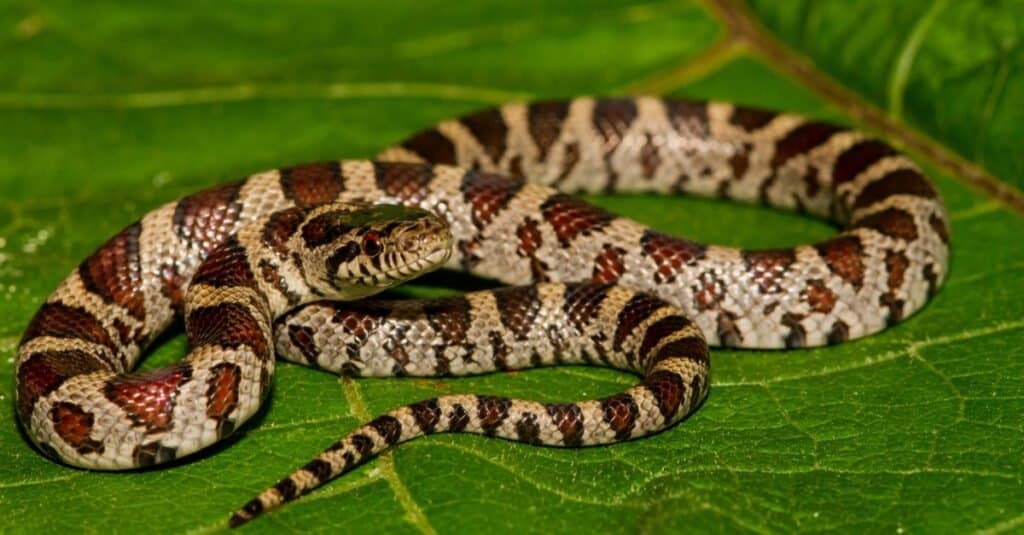
Eastern milk snakes are very beneficial animals, especially for farmers, as they hunt down small rodents.
©Jay Ondreicka/Shutterstock.com
Common Water Snake
| Common Water Snake | |
|---|---|
| Range | All of Wisconsin, in or near bodies of water |
| Length | 24-40 inches |
A rather formidable-looking snake, the common water snake has a heavy body with keeled scales and can grow between 24-40 inches long. These snakes live all over Wisconsin anywhere there is water, usually in or close to clean rivers. They eat fish, amphibians, and crayfish, and can often be seen swimming through the water or basking on rocks or in branches hanging over the water.
People often get scared thinking these snakes are cottonmouths, but don’t worry—there are no cottonmouths in Wisconsin. Water snakes are not venomous, but they can have a bit of an angry attitude and bite hard, so it is best to leave them alone.
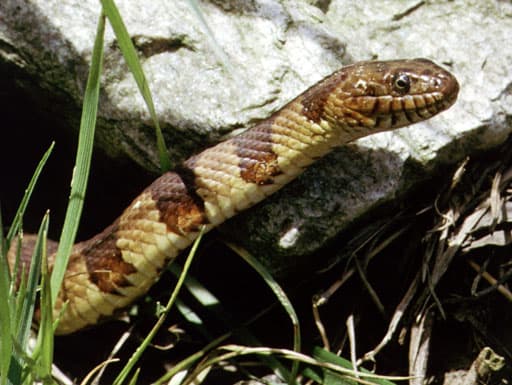
These snakes live anywhere there is water, usually in clean rivers.
Other Snakes Found in Wisconsin
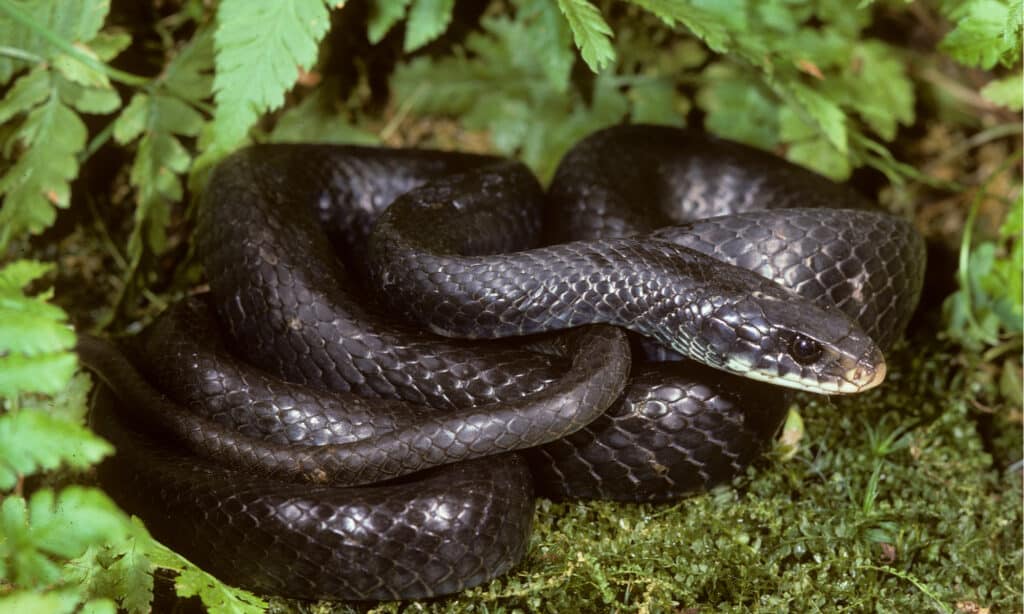
Northern black racers are just one of Wisconsin’s 37 reptilian species.
©Breck P. Kent/Shutterstock.com
Wisconsin has 19 species of amphibians (salamanders and frogs) and 37 species of reptiles (turtles, snakes, and lizards) residing in the state. Out of these species, seven are categorized as endangered, one is classified as threatened, and 21 are recognized as species of special concern.
Wisconsin’s reptiles are reliant on sandy soils, which are typically warmer and drier than other soils. These areas with slightly higher temperatures allow reptiles to exist in the state, even though it is relatively far north.
Here are other snakes found in Wisconsin:
- Black rat snake
- Eastern garter snake
- Eastern hognose snake
- Eastern ribbon snake
- Eastern worm snake
- Northern black racer
- Northern brown snake
- Northern ringneck snake
- Southern ringneck snake
- Northern water snake
Other Reptiles Found in Wisconsin
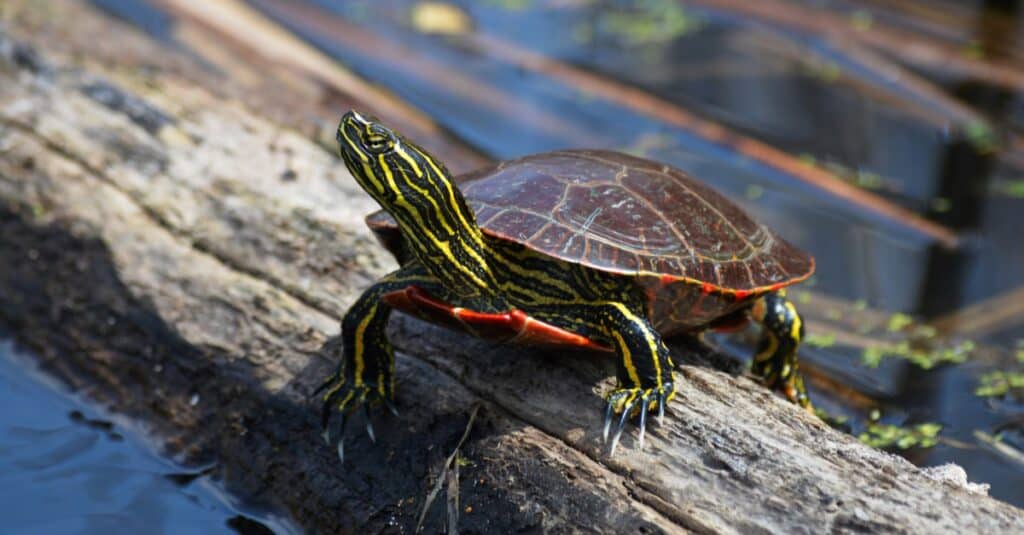
Painted turtles prefer slow-moving currents and feed on vegetable matter, small fish, and insects.
©KARI K/Shutterstock.com
The painted turtle (Chrysemys picta): An omnivore, this turtle loves to wander in slow currents where it feeds on crustaceans, insects, small fish, and vegetation. It can be recognized by its smooth dark shell covered in even patterns and dark olive or black skin with colorful stripes.
The species can be found throughout North America, and even in Southern Canada and Northern Mexico.

Ornate box turtles have a wide and varied diet including fruit, grass, insects, and invertebrates.
©Steve Byland/Shutterstock.com
The ornate box turtle (Terrapene ornata ornata): This terrestrial species of turtle’s claim to fame is its status as one of just two such species belonging to the Great Plains. It can be recognized by a brownish shell decorated in yellow lines which radiate from the center to the edges. The ornate box turtle is an omnivore and eats fruit, grass, insects, and small mammals and as a result, is rarely short of sustenance.
The prairie skink (Plestiodon septentrionalis): Recognizable by its dark coloration and light stripes, this small lizard is capable of growing up to 9 inches. It enjoys a diet of insects although it seems to exclude ants from the menu. The prairie skink is skilled at digging and pretty elusive and considers areas close to water, rocks, and basking spots, prime real estate.
Discover the "Monster" Snake 5X Bigger than an Anaconda
Every day A-Z Animals sends out some of the most incredible facts in the world from our free newsletter. Want to discover the 10 most beautiful snakes in the world, a "snake island" where you're never more than 3 feet from danger, or a "monster" snake 5X larger than an anaconda? Then sign up right now and you'll start receiving our daily newsletter absolutely free.
Thank you for reading! Have some feedback for us? Contact the AZ Animals editorial team.

